In the years leading up to World War II, the United States, Britain, and other countries with economic interests in Asia watched with growing concern as Japan made incursions into China to expand its empire. In an attempt to stop them, the United States ended its trade agreement with Japan in 1939, instituted trade embargoes on fuel and scrap metal, and closed the Panama Canal to Japanese shipping.
In 1940 the Japanese joined Germany and Italy in signing the Tripartite (Axis) Pact, ensuring mutual cooperation in an effort to "establish and maintain a new order of things" in the world. The United States, while trying to remain neutral in the growing world conflict, implemented the largest peacetime military draft in its history. When Japan invaded Indochina in 1941, the U.S. responded by freezing Japanese assets in the U.S., thereby placing an embargo on crucial oil shipments to Japan. These measures failed to impede Japan's aggression in Asia, and diplomatic talks reached a stalemate.
On the morning of Sunday, December 7, 1941 two waves of Japanese bombers and fighter plans swooped down in a surprise attack on Pearl Harbor, Hawaii, home of the U.S. Pacific fleet. Ships in the harbor and planes at nearby Wheeler Army Air Field were destroyed, with a loss of 2,403 military and civilian lives. The following day, the U.S. and Great Britain declared war on Japan.
The Pearl Harbor attack gave the Japanese a temporary advantage in the Pacific. They seized the opportunity to take control of Guam, Wake Island, the Philippines, the Dutch East Indies, Hong Kong, Singapore, and Burma. The advance was stopped in part by British, Australian and New Zealander forces, and by the U.S. victory in the Battle of Midway in the summer of 1942.
The United States began to systematically push the Japanese back from one island stronghold to another, winning important victories at Guadalcanal in the Soloman Islands and at Saipan, Tinian and Guam in the Marianas before reaching the Philippines late in 1944. The decisive battles of the Philippine Sea and Letye Gulf effectively put the Japanese Navy out of commission, clearing the way for an invasion of the island of Iwo Jima to the north, and of Okinawa in the Japanese home islands. By June 1945 both islands were taken after long battles and significant casualties on both sides.
Meanwhile, American forces had arrived in mainland China and Burma in 1942. The Japanese continued to control conquered territory there, keeping American, Chinese and British troops on the defensive. In August 1944 the tide began to turn as the Burmese capital city of Myitkyina fell to American and Chinese Nationalist forces, although the Japanese successfully maintained their defense into 1945.
As the Allies anticipated an invasion of the home island of Japan, a top secret project was reaching its conclusion in the United States that would effectively end the war with Japan. On July 16, 1945 the U.S. government successfully tested the first atomic bomb (Trinity). Two bombs were sent to the island of Tinian. On July 26th an ultimatum was issued to Japan, requiring an immediate, unconditional surrender or face annihilation. Japan refused. The first bomb, nicknamed "Little Boy," was dropped from the B-29 bomber Enola Gay on the city of Hiroshima, Japan on August 6th. "Fat Man" was dropped three days later over Nagasaki. The death toll from the two bombs would reach more than 200,000.
On August 14, 1945 the Empire of Japan unconditionally surrendered, and "V-J Day" - Victory over Japan - was officially declared. The formal surrender agreement ending the Second World War was signed aboard the U.S.S. Missouri in Tokyo Bay on September 2.
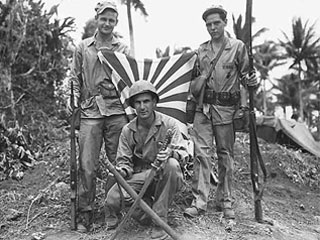
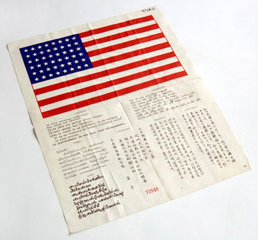
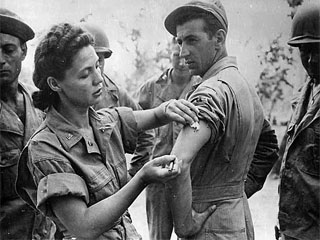
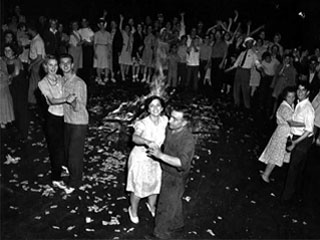
Beach Landings and Jungle Battles
Before the bombing of Pearl Harbor, the majority of American people were against U.S. involvement in the war. In the blink of an eye that attitude changed as the country united against the grave threat to American security posed by the Axis powers. The rapid build-up of military strength caused Isoruku Yamamoto, the Japanese Admiral who had orchestrated the attack on Pearl Harbor, to comment, "All we have done is to waken a sleeping giant and fill him with a terrible resolve."
The United States had military bases in the Pacific to protect its territories, among them Hawaii, the Philippines, Guam, and Alaska, so some troops, ships and other war materiel were in place in December 1941, and an additional Army air base was quickly established in Australia from which the U.S. could carry out campaigns in the Southwest Pacific. Approximately 416,000 American troops (Army, Navy and Marines) were deployed to the Pacific in 1942, and many saw combat soon after their arrival.
The Japanese made steady progress in their bid to take over the islands of the Pacific. By the spring of 1942 they had invaded the Philippines, Burma, the Soloman Islands, and Singapore. U.S. troops on Bataan in the Philippines, short on supplies, surrendered in April. As prisoners of war they faced the infamous 6-day, 90-mile forced Bataan Death March from Mariveles to Camp O'Donnell, among them, several Minnesotans.
The United States quickly went on the offensive. Doolittle's Raiders, led by Lt. Colonel Jimmy Doolittle, made a long-distance bombing run over Tokyo in April 1942 that brought the war to the home islands of Japan. The following May, the U.S. Navy was able to stop the Japanese from an invasion of New Guinea in the Battle of the Coral Sea and, a month later, defeated the Japanese at the Battle of Midway, turning the tide of the war in the Pacific.
In February 1943 the Allied forces captured the island of Guadalcanal after a difficult, five-month campaign. This victory was followed by battles in the Solomon and Gilbert Islands later that year. The Battle of Tarawa opened the way for American troops to invade the Marianas Islands, but with substantial losses. High casualties would continue as the Allies fought their way through the the Marianas in the Battles to recapture Saipan, Tinian, and Guam.
From the Marianas the Allies turned their attention toward the Philippines. The U.S. Naval victory at the Battle of Leyte Gulf in October 1944 incapacitated the Japanese fleet, and early in 1945 U.S. Army troops had recaptured Manila.
The final push toward the home islands of Japan began with the capture of Iwo Jima by the U.S. Marine Corps in March 1945. The home island of Okinawa was the next target, and would be the largest amphibious assault of the war, with more than 200,000 Allied ground troops. The Battle of Okinawa proved one of the fiercest battles of the war, with 12,513 of the 72,000 U.S. casualties killed or missing in action.
The Allies in the Pacific were gearing up for an invasion of Japan when two atomic bombs were dropped on the Japanese cities of Hiroshima and Nagasaki, an action that brought a swift closure to the war in the Pacific. The Japanese surrendered on August 14th, and the formal surrender agreement was signed on September 2, 1945.

Experiences Abroad
Minnesotans serving in the South Pacific found themselves in a culture very different from America. While some appreciated the natural beauty and warm climate, others found it hard to adjust to their island paradises. Camped out in the jungle, they coped with extreme heat and humidity, and endured the threat of such diseases as malaria and Cystosomiasis. Combat conditions were miserable, and those on duty in Field hospitals faced challenges they could only have imagined back in the States.
Josephine Downey, serving with the WAC in the Pacific, recorded many of her impressions in letters sent home to her family in St. Paul. Shortly after her arrival in 1944 she referred to her new post as "a glorified summer camp – a la Lake Geneva", with new barracks, and a pristine beach just a stone's throw away. With preconcieved notions of "diseases and head hunters", she was quick to reassure the folks back home that "we are definitely in friendly territory".
Red Cross recreation worker Gertrude Esteros was stationed first in New Guinea and later in the Philippines. She recalled the jungle-related illnesses that were unfamiliar to medical personnel and combat stresses that were a part of daily life at the field hospital, and how important her role as a listening ear became to the patients she attended.

Pearl Harbor
"Yesterday, December 7, 1941 - a date which will live in infamy - the United States of America was suddenly and deliberately attacked by naval and air forces of the Empire of Japan."
With these words, President Franklin D. Roosevelt began his response to the Japanese attack on Pearl Harbor, on the Hawaiian Island of Oahu. Relations with Japan had been tense over U.S. trade embargoes on fuel, oil and scrap metal placed in an attempt to halt Japanese aggression in China. The U.S. government had been in negotiations with the Japanese, but a decoded message proved that Japan intended to break off the talks on December 7th. A warning of the possibility of war with Japan was sent to naval command at Pearl Harbor, but was not received until after the attack.
The first sign of the enemy was registered at 3:42 a.m. on the morning of the attack by the minesweeper Condor. While patrolling a short distance outside the harbor entrance the ship sighted a submarine periscope. The Condor signaled the U.S.S. Ward,and at 6:45 a.m. the Ward's crew, including many boys from St. Paul, fired upon the Japanese mini-sub - the first American shots of the war. The action was reported, but was believed to have been a false sighting and the report was held for verification.
Although the first Japanese planes were seen on radar nearly an hour before the air strike began, the sighting was believed to be a group of American B-17 bombers flying in from California. Because no warning was issued, the attack came as a surprise, particularly to military personnel and civilians living on the island. The first wave began at 7:55 a.m. with a raid on Wheeler Air Field and Hickam Field, which destroyed most of the U.S. planes on the ground. Torpedoes hit and destroyed several U.S. ships moored in Battleship Row on Ford Island, including the U.S.S. Oklahoma, the Arizona, the Nevada, the Utah, and the California.
The second wave of the raid began at 8:54 a.m. with an attack on the navy yard dry dock, resulting in the loss of more battleships and destroyers. By 10:00 a.m. the air attack had ended. The Japanese had hoped to destroy aircraft carriers, but none were in the harbor on December 7th. The Japanese did not know the whereabouts of the carriers and, satisfied with the success of the raid, did not send the third wave of planes to the harbor.
The death toll of military personnel and civilians at Pearl Harbor totaled 2,403 with another 1,178 wounded. A total of 21 ships were destroyed or damaged. 188 planes were lost and 139 were damaged. Of the ships sunk, all but three were repaired and returned to service.
Americans across the country reacted to the news of Pearl Harbor with shock and disbelief. Many had no idea where Pearl Harbor was located. None would forget where they were on December 7th.
President Roosevelt concluded his speech on December 8th with a declaration of war on Japan:
"I ask that the Congress declare that since the unprovoked and dastardly attack by Japan on Sunday, December 7, 1941, a state of war has existed between the United States and the Japanese Empire."
America was at war.

V-J Day & Coming Home
"Japan Surrenders!" "War Over!"
The headlines of newspapers across the country declared the news when Japan surrendered unconditionally on August 14, 1945. Joy and relief sept the land as families anticipated the return of loved ones from the war.
In Minnesota, spontaneous celebrations erupted in the streets of cities and towns, and people flocked to nearby churches to give thanks for the hard-won peace. Arlett Bredeson of Minneapolis wrote of the crush of people downtown and the sight of tickertape raining down in the streets. Another Minneapolitan, Doris Shea Strand, also recalled the "wild celebration" in her hometown. When the formal surrender of Japan took place on September 2nd, President Truman declared that day the "official" V-J Day, and the celebrations were repeated.
For servicemen and women it was the beginning of the end, as they added up their service points in eager anticipation of coming home. For some, it would be several months before their release from duty, and military life took on a monotonous quality. Josephine Downey, a member of the WAC serving as a cryptographer in the Pacific, wrote that she didn't expect a quick discharge, but that she would be "mighty thrilled" to be home again. Anne Bosanko Green, who wrote a euphoric letter home at the height of the V-J (Victory over Japan) celebration on her base in California, later wrote of her boredom and strong desire to be free of the restrictions of army life.
For those families with gold stars in their windows, the end of the war was bittersweet. Too many young men lay in graves in foreign soil, and too many would return with war wounds, both physical and psychological. Lives would be resumed, though for many the adjustment back to civilian life would not be easy. A strong economy promised a brighter future, and the G.I. Bill of Rights provided many servicemen with opportunities for education and home ownership, though a housing shortage would put a damper on expectations of many.
The end of the war had a different impact on the thousands of young women who had filled the gap in the workforce or joined the military and found a new independence. They would relinquish their jobs to returning servicemen and most would return to traditional roles, setting the stage for the post-war Baby Boom.

Citations:
- Panama Canal. Google Maps, 2007.
- Tripartite Pact. Wikipedia.org, 2007.
- Attack on Pearl Harbor. Wikipedia.org, 2007.
- Remembering Pearl Harbor. National Geographic, 2001.
 Photo: Planes and hangars burning at Wheeler Army Air Field, Oahu, soon after it was attacked in the morning of 7 December 1941,
as seen from a Japanese Navy plane.
Photo: Planes and hangars burning at Wheeler Army Air Field, Oahu, soon after it was attacked in the morning of 7 December 1941,
as seen from a Japanese Navy plane.- Battle of Guam (1941). Google Maps, 2007.
- The Battle of Wake Island. Wikipedia.org, 2007.
- Battle of the Philippines. Wikipedia.org, 2007.
- South West Pacific theatre of World War II. Wikipedia.org, 2007.
- Battle of Hong Kong. Wikipedia.org, 2007.
- Battle of Singapore. Wikipedia.org, 2007.
- Burma. Wikipedia.org, 2007.
- Battle of Midway: 4-7 June 1942. Department of the Navy, Navy Historical Center, 2005.
- Guadalcanal Campaign. Wikipedia.org, 2007.
- Battle of Saipan. Wikipedia.org, 2007.
- Battle of Tinian. Wikipedia.org, 2007.
- Battle of Guam (1944). Wikipedia.org, 2007.
- Battle of the Philippine Sea. Wikipedia.org, 2007.
- Battle of Leyte Gulf. Wikipedia.org, 2007.
- The Battle for Iwo Jima. U.S. Department of Defense, 2007.
- Appleman, Roy E., James M. Burns, Russell A. Gugeler, and John Stevens Okinawa: The Last Battle. The United States Army, 2001.
- Myitkyina. Wikipedia.org, 2007.
- World War II: Asiatic-Pacific Theater, 1941-1946. Department of the Navy, Navy Historical Center, 2000.
- Trinity. Los Alamos National Laboratory, 2006-2007.
- China Burma India Theater of World War II. Wikipedia.org, 2007.
- Little Boy and Fat Man. National Atomic Museum, 2003.
- VJ Day. Minnesota Historical Society: Minnesota's Greatest Generation, 2005.
- World War II Timeline. World War II History Info, Interesting.com, 2001-2003.
- Lewis, Brenda Ralph, Women at War: The Women of World War II - At Home, at Work, on the Front Line. Pleasantville, New York: Amber Books Ltd., The Reader's Digest Association, Inc., 2002.
- American War and Military Operations Casualties: Lists and Statistics. Department of the Navy, Navy Department Library, Naval Historical Center, 2005.
- Matloff, Maurice and Edwin M. Snell, STRATEGIC PLANNING FOR COALITION WARFARE 1941-1942: Strategic Employment in the Pacific. Center for Military History, United States Army, 2002.
- Himchak, Elizabeth Marie, The Bataan Project. University of San Diego, 1999.
- American Experience: Bataan Rescue. Public Broadcasting Service.
- Doolittle Raid. Wikipedia.org, 2007.
- Battle of the Coral Sea. Department of the Navy, Naval Historical Center, 2000-2001.
- Battle of Midway Department of the Navy, Naval Historical Center, 1999-2001.
- Guadalcanal Campaign. Department of the Navy, Naval Historical Center, 2001-2002.
- Battle of Saipan. Wikipedia.org, 2007.
- Battle of Tinian. Wikipedia.org, 2007.
- Battle of Guam (1944). Wikipedia.org, 2007.
- The Manhattan Project. National Atomic Museum, 2003.
- Downey, Josephine, Josephine Downey Papers, 1929-1947. Minnesota Historical Society Manuscripts Collection.
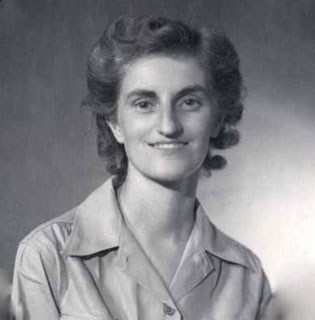 Photo: Josephine Downey, 1944-1945.
Photo: Josephine Downey, 1944-1945.- Esteros, Gertrude; Thomas Saylor, Interviewer, Oral History Interview with Gertrude Esteros. Minnesota's Greatest Generation Oral History Project, Thomas Saylor; Minnesota Historical Society Oral History Collection, 2003.
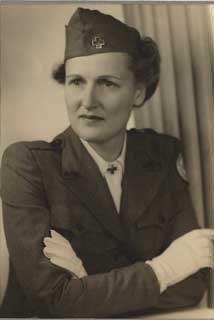 Photo: Gertrude Esteros, used with permission.
Photo: Gertrude Esteros, used with permission.
- Our Documents: Declaration of War. Franklin Delano Roosevelt Presidential Library and Museum, 2009.
- Remembering Pearl Harbor. National Geographic, 2001.
- USN Ships: USS Ward (Destroyer # 139, later DD-139 and APD-16), 1918-1944. Naval Historical Center, 2000-2003.
 Artwork: U.S.S. Ward.
Artwork: U.S.S. Ward. Photo: 4"/50 gun crew on USS Ward, after Pearl Harbor attack.
Photo: 4"/50 gun crew on USS Ward, after Pearl Harbor attack.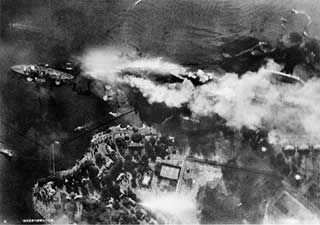 Photo: Japanese aerial photo of Pearl Harbor's "Battleship Row" soon after USS Arizona exploded.
Photo: Japanese aerial photo of Pearl Harbor's "Battleship Row" soon after USS Arizona exploded.- Pearl Harbor Attack, 7 December 1941, Related Resources. Department of the Navy, Naval Historical Center, 2000-2001.
- V-J Day. Minnesota Historical Society: Minnesota's Greatest Generation, 2005-2007.
 Photo: Young women praying in church, Minneapolis, V-J Day.
Photo: Young women praying in church, Minneapolis, V-J Day.- Formal Surrender of Japan, 2 September, 1945. Department of the Navy, Naval Historical Center, 1999.
- Bredeson, Arlett, Orville Mickelson Papers. Minnesota Historical Society Manuscripts Collection.
- Strand, Doris Shea; Thomas Saylor, Interviewer, Minnesota's Greatest Generation Oral History Project, Thomas Saylor; Minnesota Historical Society Oral History Collection, 2002.
- Downey, Josephine, Josephine Downey Papers, 1929-1947. Minnesota Historical Society Manuscripts Collection.
- Green, Anne Bosanko, Anne Bosanko Green and Family Correspondence, 1944-1946. Minnesota Historical Society Manuscripts Collection.
- G.I. Bill History. United States Department of Veterans Affairs, 2007.


